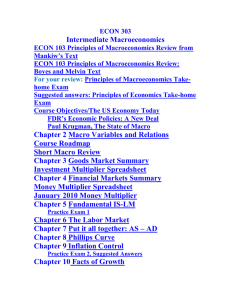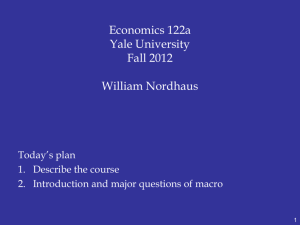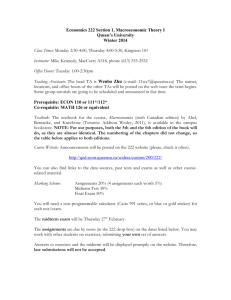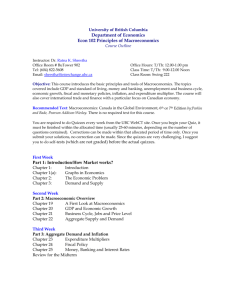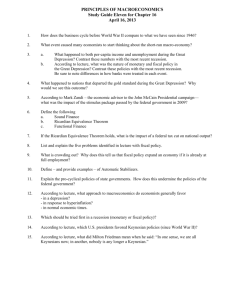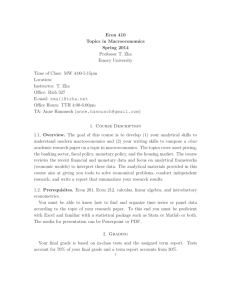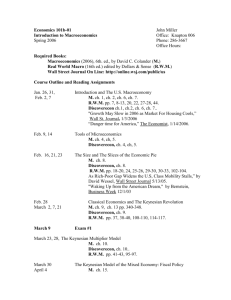Economics 157b Economic History, Policy, and Theory Short
advertisement
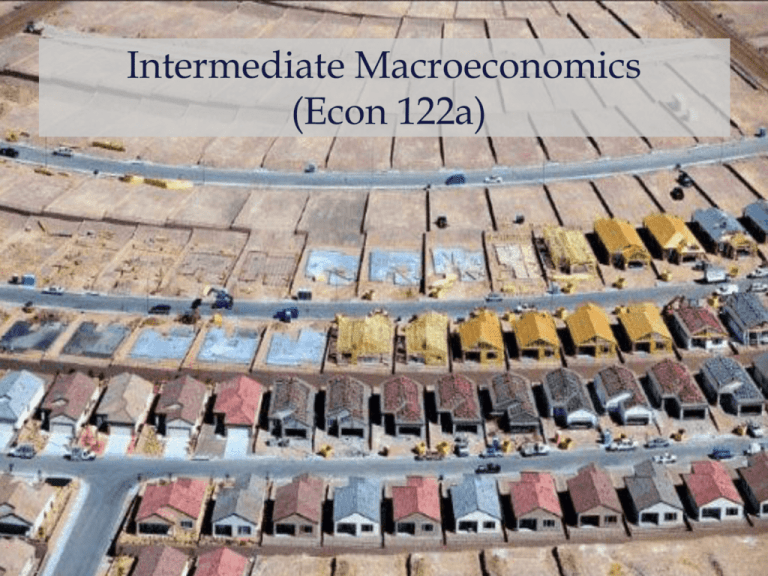
Intermediate Macroeconomics (Econ 122a) 1 Today’s plan 1. Describe the course 2. Introduction and major questions of macro 2 Course Syllabus DESCRIPTION AND PREREQUISITES • The course covers business cycles, economic growth, major macro topics, and their application to fiscal and monetary policy and history. • This course is to be taken after completing both terms of Introductory Economics. Exceptions will be rare. Calculus will be used. • Course web page is www.econ.yale.edu/~nordhaus/homepage/Econ122_Fall2013.htm 3 Readings • • TEXTBOOK. – Greg Mankiw, Macroeconomics, eighth edition, Worth 2012. • For textbook options, see web page. • There are many supplemental readings, available online or on the course web site. •4 Schedule • We will generally meet M W 11:35-12:50 • We will occasionally meet on Friday for optional special sessions. You should make sure you are available on Fridays. • Lectures will be posted after the class. 5 Tests and Grading • There will be one mid-term examination in class on Wednesday, October 9 The final examination will be three hours and is Dec 13. • There will be eight required problem sets (half randomly graded). A short paper is due at the end of the semester. • The grade is based circa 50 percent on the final exam, 20 percent on the hour tests, and 30 percent on the problems and paper. • Grade distribution (verbal description in class). 6 Sections • There will be sections led by teaching fellows from Department of Economics. Each student will be assigned to a section. • Sections will go over the analytical material from the course, cover questions raised by students, and review problems and exams. • Tentative section times are: Wednesday 7:00-7:50 and 8:00-8:50 pm Thursday 4:00-4:50 and 5:00-5:50 pm Thurs 7:00-7:50 and 8:00-8:50 pm 7 Limited enrollment • Limit to 120 students (more or less) . • The following is the priority list: • All those who got bumped last year*; senior*, then junior economics majors*; other seniors* and juniors; sophomores who are declared economic majors. • Oversubscribed groups will be selected by lottery. • Freshmen are not eligible. * Based on historical experience, * are likely to get in, un* are either in a lottery or unlikely. 8 Alternative macroeconomics courses: Econ 122b (Moscarini). Same course, different textbook. Econ 126b. Intensive version. More analytical and mathematical. 9 For those who have had enough macroeconomics for today... 10 Question for you Take out a piece of paper and answer the following. Put your name on the paper, and pass it in: What macroeconomic question would you most like to answer or learn about this term? 11 What is macroeconomics? • Macroeconomics is the study of the overall behavior of economies (output, inflation, unemployment, trade balance, financial markets, …) • A critical point is that the total behaves differently from simple adding up of the parts – Think of revolutions – or bank runs – or avalanches See http://www.youtube.com/watch?v=B0RWLxOFGLY 12 Major themes There are two major recurrent themes running through macro: i) Business cycles ii) Economic growth Virtually every macroeconomic issue revolves around these issues, or a confusion concerning them. 13 The fundamental problem of cycles “The resources of nature and man’s devices are just as fertile and productive as they were. The rate of our progress towards solving the material problems of life is not less rapid. But today we have involved ourselves in a colossal muddle, having blundered in the control of a delicate machine, the working of which we do not understand.” [ J.M. Keynes, The Great Slump of 1930 ] 14 Business cycles One major set of issues involves the business cycle. These are the short-run changes in output, employment, and inflation. Important business cycle questions: 1.What caused the global financial crisis of 2008? Why did it lead to the Great Recession that is still going on? 2.Why has unemployment risen so sharply and remained so high? 3.Should governments increase or cut spending today? 4.How does the Fed affect output and inflation? 15 Origins of the Great Recession (2007 - ???) • Housing prices peaked in mid 2006 and then fell about 40 percent. On average, households lost $60,000. • In 2007, investors suddenly discovered that subprime mortgages were much riskier than had been supposed. • This led to financial problems, especially for highly leveraged financial intermediaries (banks, investment banks, etc.). • Risk premiums increased, credit was tightened, and there was a series of financial panics in 2007 - 2008. • These led to bank runs and multiple bankruptcies or near-ones in 2008. • The Fed responded forcefully. The Congress passed a bailout bill in 2008 and a major “stimulus package.” • The federal deficit and debt shot up with recession and stimulus. • But the economy is stuck at high unemployment and relative stagnation. • The end is not in sight…. 16 Unemployment rate over the cycles 17 Shaded areas are NBER recessions. Real GDP over the cycle 17,000 Potential GDP Actual GDP 16,500 16,000 15,500 15,000 Large GDP “gap” 14,500 14,000 13,500 2005 2006 2007 2008 2009 2010 2011 2012 2013 18 120 Net federal debt/GDP (%) 100 60 40 Recession and stimulus World War II 80 20 0 1930 1940 1950 1960 1970 1980 1990 2000 2010 2020 19 Today’s macro dilemma • Because short-run interest rates are zero, the Fed cannot use conventional monetary policy . • It today relies on controversial “quantitative easing.” • Fiscal policy is more effective in today’s environment. • But fiscal expansion will increase the large and growing government debt; and faces strong opposition from conservatives and deficit hawks. You will understand each of these when you finish Econ 122 20 Economic growth Economic growth concerns the trend in output over the long run. Important growth questions: Why is average American 10x richer than Americans 100 years ago? What are the sources of growth? How will the growing government debt affect growth over the medium term? In macroeconomics, we use the neoclassical growth model to understand economic growth. Per capita output 3 big regions Per capita output (2005 US$) 40,000 United States China Sub-Saharan Africa 4,000 400 1980 1985 1990 1995 2000 2005 2010 22 Per capita growth trends in 3 big regions 23 International macro In a world of rapid globalization, international macro becomes increasingly important. Role of exchange rates, international trade, currencies. The biggest issues today are: • What are “global imbalances?” Why does the US have such a huge current trade deficit while China has such a large surplus? How will these resolve? • What is the reason for the Euro crisis? Will the Eurozone fall apart, or evolve closer to a standard fiscal union? Is disaster waiting around the corner? 24
